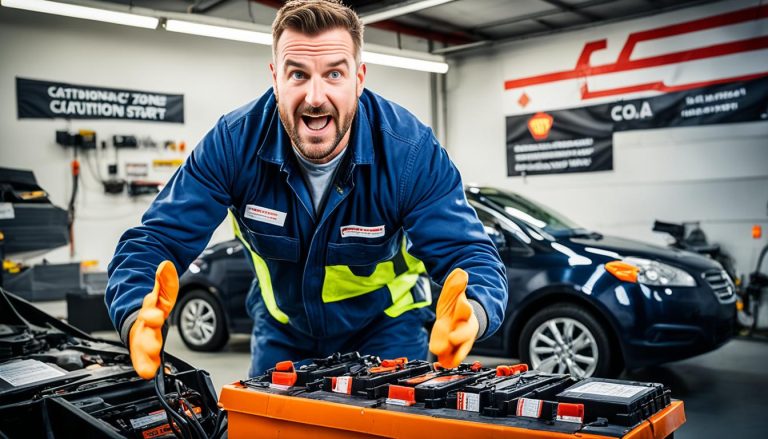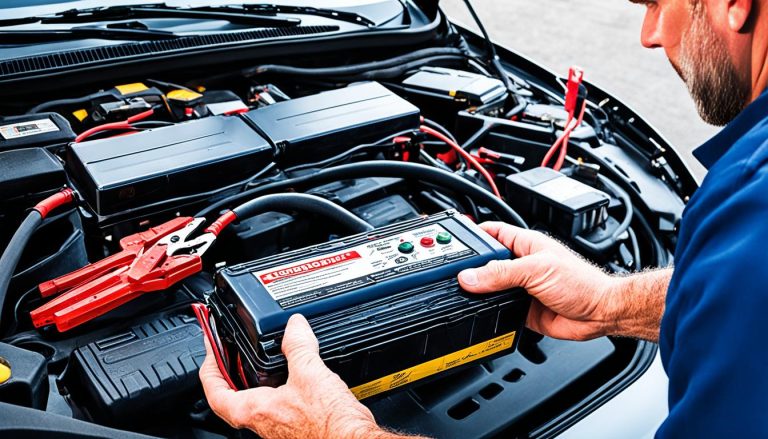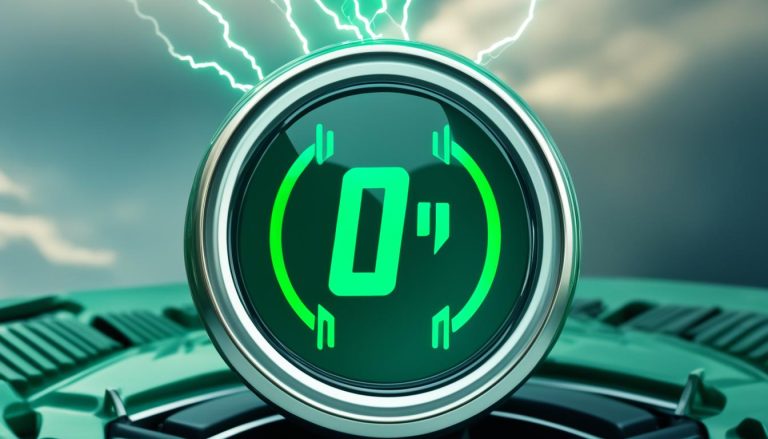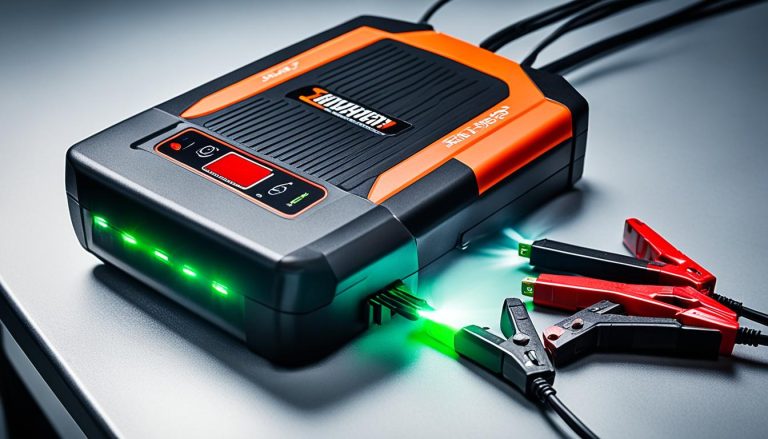Battery Smoking When Trying to Jump Start? Fix It Now!
batterychargers.site and its partners may earn a commission if you purchase a product through one of our links
Picture yourself on a crisp morning, ready to start your day, when suddenly your car refuses to come to life. You set up the jumper cables, eager to get on the road, but instead of hearing the comforting rumble of the engine, you’re met with the alarming sight of battery smoking when trying to jump start. It’s a situation no driver wants to face—both confusing and potentially dangerous.
Not to worry, though, because understanding the root of this issue is the first step in car troubleshooting. Whether you’re a seasoned pro at jump starting a car or a newcomer to the world of car maintenance, it’s crucial to know why your car battery smokes and how to address it swiftly and safely.
Key Takeaways
- Identify the root causes of a smoking battery during a jump start to ensure effective troubleshooting.
- Learn the importance of proper car maintenance to prevent hazardous situations.
- Discover safety measures to protect yourself and your vehicle when jump starting a car.
- Understand the vital signs indicating potential battery failure and preemptive actions to take.
- Gain knowledge on the correct protocols for car troubleshooting and when to seek professional help.
- Explore tips for extending the life of your car battery and avoiding common jump start errors.
Battery Smoking When Trying to Jump Start: Understanding the Risks
When you’re faced with a non-responsive vehicle, a jump start seems like a straightforward solution. However, encountering battery smoking during the process can stop you in your tracks. Grasping the potential hazards associated with battery problems is pivotal for the safety of both you and your vehicle.
Why Do Car Batteries Smoke?
Battery issues like smoking can stem from a variety of factors. Often, it is the sign of a deeper car battery problem such as an internal short circuit, damaged cells, or a severely overcharged battery. Smoking could indicate that your battery is releasing dangerous gases, which could pose a risk of fire or explosion if ignited by a spark or excessive heat.
The Role of the Car Battery and Jump Starting Process
The car battery is the lifeblood of your vehicle’s electrical system, providing the necessary power to start your engine and operate its many electronic components. During a jump start, a healthy battery from another vehicle lends electrical power to the drained battery, which, under normal circumstances, should revive the car’s ability to start. However, when there’s smoking, it’s a clear indication that something is amiss.
When Is a Car Battery Too Dead to Jump Start?
Not all batteries can be saved by a jump start. If your car battery has been left discharged for too long or has been damaged, it may no longer be capable of holding a charge. In cases where the battery voltage is excessively low, attempting a jump could result in car engine smoking or even failure of the vehicle’s electrical components.
How an Overcharged Battery Can Lead to Smoke
An overcharged battery implies that it has received more voltage than it can manage, leading to overheating and swelling. This condition prompts the release of hydrogen gases, which could potentially catch fire or explode, especially during a jump start. If you notice your battery case bulging or feel it unusually hot, the risk of it smoking becomes significantly higher.
In the face of a smoking battery, remain calm, disconnect the jump leads quickly, and keep a safe distance. It’s not just about fixing the immediate issue, it’s about ensuring your car’s long-term reliability and your safety on the road.
Being aware of these potential battery problems and understanding how they affect the overall health of your vehicle are fundamental in averting risks associated with jump starting. Regular checks and maintenance go a long way toward preventing any surprise smoke signals from under your hood.
Signs Indicating Potential Battery Failure and Preventive Measures
Your vehicle’s battery is the cornerstone of its electrical system and, just like any other part, it can fail. Being aware of the signs of impending battery failure is crucial for timely car maintenance and can spare you the worrisome sight of car battery smoking or even more severe battery failure. Simple, vigilant car troubleshooting steps can help you identify problems early and take preventative actions.
- Slow Engine Cranking: It’s a classic symptom telling you that your car battery may be on its way out.
- Corrosion on the Battery Terminals: White, ashy deposits may indicate that it’s time to clean your terminals or have them inspected.
- Battery Age: Typically, a car battery lasts about 3-5 years. If yours is older, it may be time for a check-up or replacement.
- Unusual Smells: A rotten egg scent could signify a leaking battery, which is a clear call to action.
- Visible Damage: Any visible damage to the battery casing is a red flag that needs immediate attention.
To avert the troubles of car battery smoking, here are some crucial preventive measures you should consider:
| Maintenance Task | Benefits |
|---|---|
| Proper Charging Habits | Avoids overcharging and prolongs battery life |
| Clean Battery Terminals | Ensures good contact and prevents power loss |
| Regular Inspection for Corrosion | Prevents voltage drops and starting issues |
| Checking Battery for Leaks | Prevents damage to vehicle components and potential safety hazards |
| Seeking Professional Assistance | Ensures thorough diagnosis and remediation |
If you’re unsure about the health of your battery, it’s far safer to consult with a professional instead of risking the jump start. This can prevent car battery smoking and the associated electrical and fire hazards. Remember that regular car maintenance can save you not only from vehicle troubles but also from unnecessary stress and safety risks.
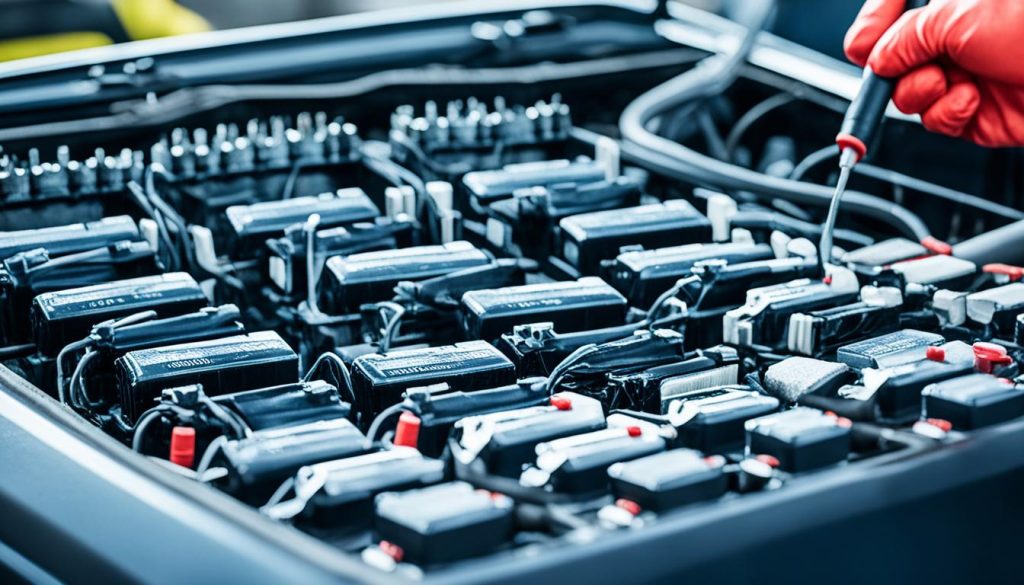
Jump Starting a Car: Step-by-Step Safety Check
Welcome to the pivotal step in resurrecting your vehicle’s dead battery. Before jump starting a car, it is imperative to perform a safety check to prevent any damage to your vehicle or harm to yourself. Keep in mind, jump starting a car is not just about reviving a dead battery; it’s also about ensuring the alternator’s health and making proper cable connections.
Correct Cable Connection: Positive to Positive, Negative to Ground
First things first, identifying and connecting the jumper cables correctly is essential to avoid shorting the electrical system. The positive terminal is typically marked with a plus sign (+) and is usually connected with a red cable, while the negative terminal will have a minus sign (-) and is connected with a black cable.
- Connect the red cable to the positive terminal of the dead battery.
- Attach the other end to the positive terminal of the good battery.
- Connect the black cable to the negative terminal of the good battery.
- Finally, attach the other end of the black cable to a metal surface on the engine block of the car with the dead battery, away from the battery itself, to prevent sparks.
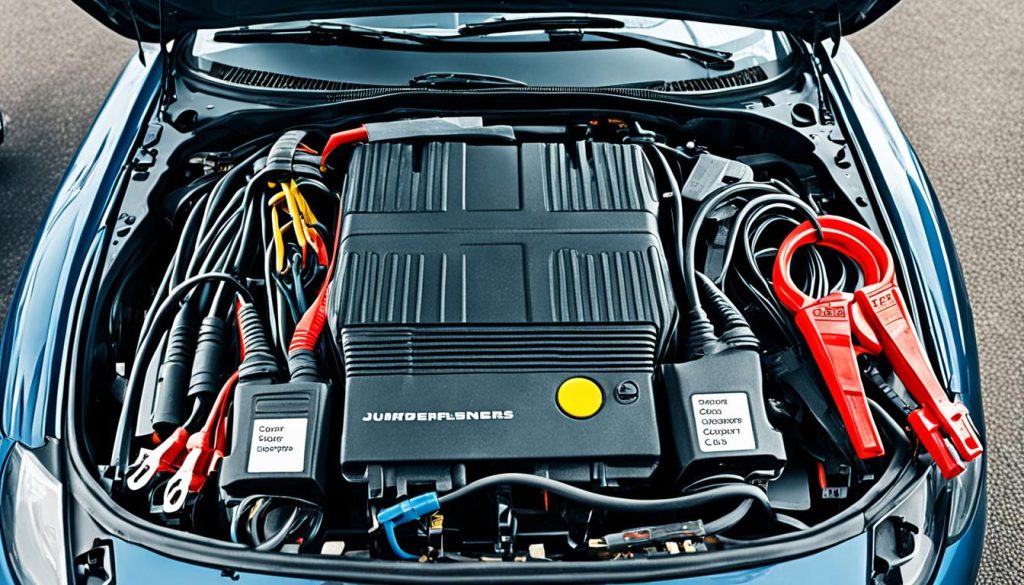
Charging Time and Techniques for a Dead Battery
The charging time can vary, and it’s crucial to know the approach for your specific situation. An average car battery might take around 4-6 hours to charge if it’s completely dead. However, a linear charger may take up to 12 hours, while a multi-stage charger might get you up and running in a fraction of that time.
| Charger Type | Approximate Charging Time | Notes |
|---|---|---|
| Linear Charger | 12 hours | Consistent, slow charge rate |
| Multi-Stage Charger | 3-4 hours | Adjust charge rate based on battery status |
| Trickle Charger | 24+ hours | For maintaining charge over long periods |
Alternator Health: A Key Factor in Jump Starting Success
Remember, a healthy alternator is just as crucial as a strong battery. If your car’s alternator isn’t functioning correctly, it won’t charge the battery while the engine runs, and you could be back to square one with a dead battery. If you’re experiencing ongoing car battery issues, it’s wise to check the alternator’s performance.
- Inspect the alternator belt for any signs of wear or damage.
- Listen for unusual sounds, like growls or whining, which may indicate bearing problems.
- Measure the charging voltage and current with a multimeter while the engine is running to check for adequate output.
Maintaining your car’s battery and ensuring a healthy alternator can prevent unexpected issues, saving you time and stress. In the event you encounter a dead battery, following these steps for a safe jump start will help you hit the road with confidence.
How to Respond to Battery Smoke Emergencies
If you encounter battery smoking during a jump start, it’s critical to take immediate safety measures. To ensure your well-being and prevent further car emergency situations, follow this step-by-step guide:
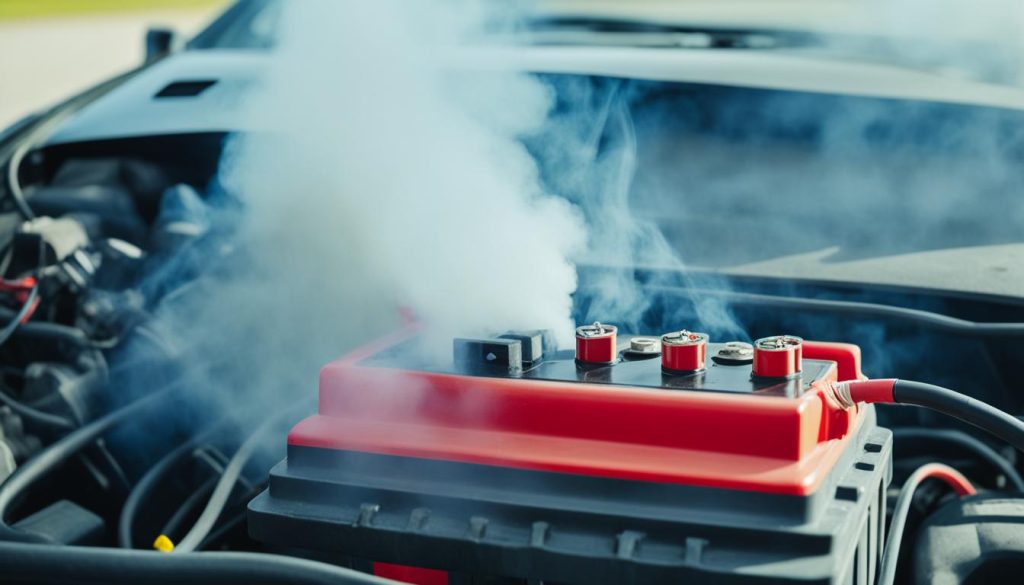
- Stop the jump-start process instantly and remove yourself from any potential danger.
- Wait for the smoke to clear completely before approaching the battery or vehicle.
- Once it’s safe, disconnect the battery terminals starting with the negative cable to prevent further damage.
- Inspect the battery closely for any visible damage, such as cracks or leaks.
Continuing the charge or attempting another jump start without assessing the condition of your car could lead to significant car troubleshooting issues. This is why it’s crucial to:
- Place the battery in a secure and ventilated space, away from the vehicle.
- Consult with a reliable car maintenance professional to evaluate whether the battery needs replacement, or if other electrical problems may be contributing to the issue.
A table of safety measures and precautions is provided below to help you effectively deal with battery emergencies in the future.
| Emergency Action | Reason | Preventive Measure |
|---|---|---|
| Stop the process immediately | Prevents escalation to fire or explosion | Regular inspection of battery condition |
| Avoid inhaling smoke | Smoke may contain toxic chemicals | Wearing a protective mask during jump start |
| Disconnect battery after smoke clears | Allows for safe inspection of the damage | Always have safety gloves and goggles in your car |
| Consult a professional | Verify if it’s a battery or electrical system issue | Have a trusted mechanic’s contact information |
Taking these car emergency and car maintenance steps will help to keep you safe during battery smoking incidents and will contribute to proper car troubleshooting practices.
Car Troubleshooting: Diagnosing Smoking Battery Problems
When car troubles arise, such as when your car won’t start, battery health becomes critical to address immediately. Smoking batteries are more than just a nuisance; they are a red flag that may indicate serious electrical issues that need your attention. In times like these, knowing the basics of car troubleshooting can save you both time and potentially expensive repairs.
What to Inspect When Your Car Won’t Start
If you turn the key and find that your engine performance is lackluster, or worse, non-existent, it’s important to first check for obvious signs. Bad terminal connections might be the culprit, disrupting the flow of electricity needed to start the engine. This lack of power can also cause other electrical components to fail. Carefully inspect starter windings for short circuits which can prevent the engine from turning over.
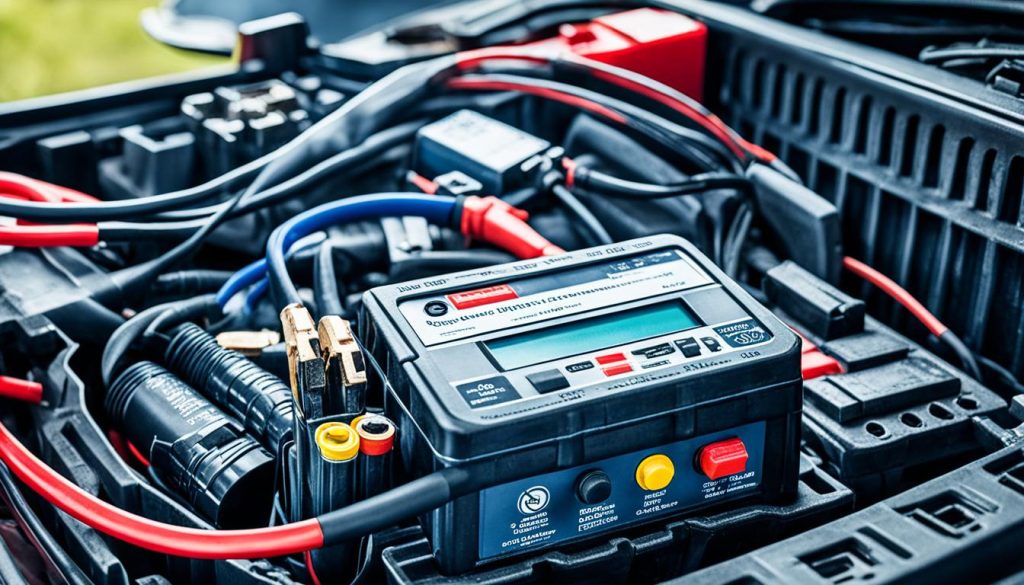
Next, look for a burnt fusible link, especially if you’ve made the common mistake of reversing jumper cables during a jump start. A non-responsive battery after a jump could suggest deeper electrical issues, so take note if your battery remains dead despite your best efforts to charge it.
The Link Between Engine Performance and Battery Health
Better engine performance is often linked to having a healthy battery. When troubleshooting, gauge the battery’s condition by checking its voltage and looking for signs of corrosion or damage. If the battery’s integrity is compromised, it not only affects your engine’s ability to start but can also impact overall vehicle performance and reliability.
When to Contact a Professional for Battery Assistance
While some car issues can be solved with a bit of DIY knowledge, others, like a smoking battery, call for professional battery assistance. It’s advisable to reach out to a trusted technician who can provide a thorough diagnosis and safe resolution. They have the expertise to determine if the problem extends beyond the battery and into the vehicle’s electrical system, ensuring proper repair and your safety on the road.
| Issue | Possible Cause | DIY Check | Professional Help Needed |
|---|---|---|---|
| Car won’t start | Bad terminal connections, shorted starter windings | Inspect battery terminals and starter | If issue persists after inspection |
| Battery smoking | Reversed jumper cables, internal short | Check for burnt fusible links | Immediately, to prevent further damage |
| Non-charging battery | Electrical system failure | Attempt jump start with proper cables | If battery does not hold charge post-jump |
| Engine performs poorly | Weak or damaged battery | Test battery voltage | For electrical system evaluation |
Remember, while car troubleshooting may seem daunting at first, understanding the basics of what to inspect when your car won’t start, the relevance of an engine’s performance to battery health, and knowing when to seek professional battery assistance can make all the difference. Keep a watchful eye on the health of your battery; it’s the heartbeat of your vehicle’s electrical system.
Battery Maintenance: Tips to Extend Your Car Battery Life
Proper car battery maintenance is essential for reliability and longevity of your vehicle’s battery life. Regular visual inspections to check for any signs of damage or wear can prevent unexpected failures down the road. Keep those terminals pristine; a buildup of corrosion can interrupt the flow of electricity, potentially leading to starting issues and reduced battery efficacy. Implementing preventive maintenance tasks into your routine is more than just a suggestion — it’s necessary for keeping your car running smoothly.
It might seem obvious, but the importance of using quality jumper cables and ensuring solid connections cannot be overstressed. Poor connections can cause a resistance that may lead to hazardous smoking, or worse, a fire. It’s also crucial to remember that jump-starting is not a fix-all solution; over-reliance on this method can contribute to overheating and deteriorate your battery’s condition. Instead, consider a dedicated battery charger, especially during temperature extremes that test a battery’s limits. Such chargers condition the battery, helping you to effectively extend car battery life.
Finally, be mindful of your charging system’s overall health. A faltering alternator can surreptitiously sap the life from your battery, leading to premature wear. Stay on top of this by scheduling regular check-ups at your local service center. With these car maintenance tips, you’ll greatly decrease the likelihood of encountering any unpleasant surprises like battery smoking or unexpected power loss. Thus, extending the resilience and dependability of your car’s battery and ensuring peace of mind on your daily journeys.
FAQ
Why Do Car Batteries Smoke?
Car batteries can smoke due to a variety of issues such as overcharging, incorrect terminal connections, short circuits, or internal damage. This smoking is often the result of excessive heat or electrical resistance that causes the battery to release fumes, which are indicative of potential fire hazards and often contain harmful chemicals.
What Is the Role of the Car Battery and Jump Starting Process?
The car battery is crucial for starting the vehicle and powering on-board electronics, like lights and the GPS. The jump starting process involves using another vehicle’s battery or a portable jump starter to help start a car when its battery has insufficient charge to do so on its own.
When Is a Car Battery Too Dead to Jump Start?
A car battery is too dead to jump start if it is no longer capable of holding a charge, if it has significant physical damage, or if attempting to jump start it results in excessive heat or smoke. A professional should assess in such situations to determine if the battery needs replacement.
How Can an Overcharged Battery Lead to Smoke?
An overcharged battery can lead to smoke because the excess voltage causes an increase in internal pressure and temperature. This may lead to the release of electrolyte fumes, and in the presence of a spark or flame, the hydrogen gas within the battery can ignite, causing smoke or fire.
What Are Signs Indicating Potential Battery Failure?
Signs indicating potential battery failure include slow engine cranking upon start, visible corrosion on terminals, battery age (typically batteries last 3-5 years), unusual smells, or a swollen or damaged battery case.
What Preventive Measures Can I Take to Maintain My Car Battery?
To maintain your car battery, ensure proper charging without overcharging, keep the terminals clean and free from corrosion, regularly inspect the battery for signs of wear or damage, and have your electrical system checked periodically by a professional.
How Should I Connect Cables When Jump Starting a Car?
When jump starting a car, always connect the positive (red) clamp to the positive terminal on each battery first, then connect the negative (black) clamp to a metal ground on the car receiving the jump start—never directly to the negative terminal of its battery—to avoid sparking.
How Much Time Does it Take to Charge a Dead Battery?
Charging time for a dead battery varies, depending on the battery type and charger. It generally takes about 12 hours with a traditional linear charger, but a multi-stage charger that adjusts the current can reduce this time significantly.
How Does Alternator Health Affect Jump Starting?
Alternator health is key in jump starting because it is responsible for charging the battery once the vehicle is running. A faulty alternator can prevent the battery from charging properly and may cause issues that lead to battery smoking when trying to jump start the car.
What Should I Do If I See Smoke When Jump Starting?
If you see smoke when jump starting, immediately stop the process, disconnect the cables, and move away from the battery. Do not breathe in the smoke as it can be toxic. Once the smoke has cleared and the battery has cooled down, inspect for damage or consult a professional.
What to Inspect When Your Car Won’t Start and Battery Is Smoking?
Inspect for shorted starter windings, bad terminal connections, and check for a burnt fusible link, especially if jumper cables might have been connected incorrectly. If you notice smoke or the car still won’t start, it’s best to consult a professional.
How Does Engine Performance Relate to Battery Health?
Engine performance can be directly affected by battery health. A failing battery might not provide enough power to crank the engine properly, and poor battery condition could lead to irregular power delivery, affecting the engine’s performance and reliability.
When Should I Contact a Professional for Battery Assistance?
You should contact a professional for battery assistance if you are unsure of the condition of your battery, if it is showing signs of failure, if your car won’t start and you’ve observed smoke, or if you suspect electrical system issues beyond the battery itself.
What Are Some Tips to Extend My Car Battery Life?
To extend your car battery life, ensure regular maintenance checks, clean terminals, avoid overcharging, and reduce exposure to extreme temperatures. Also, invest in a good quality battery charger and use it to maintain charge levels, especially if your car isn’t used regularly.

